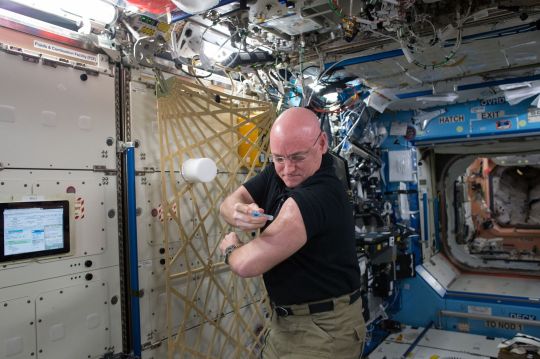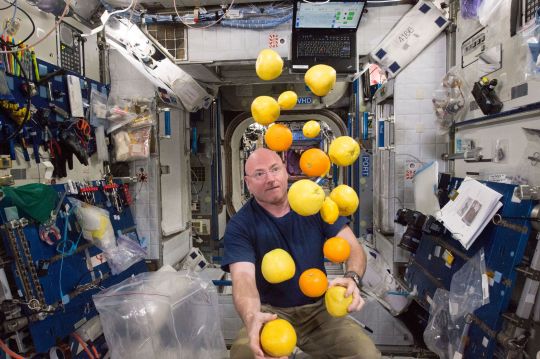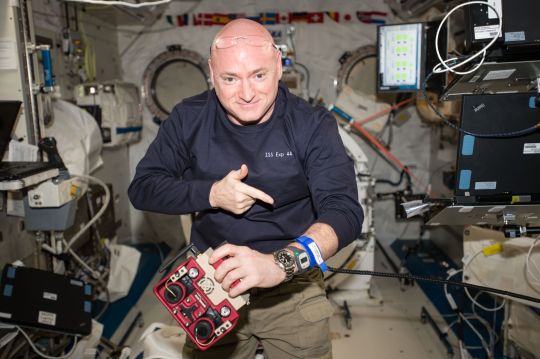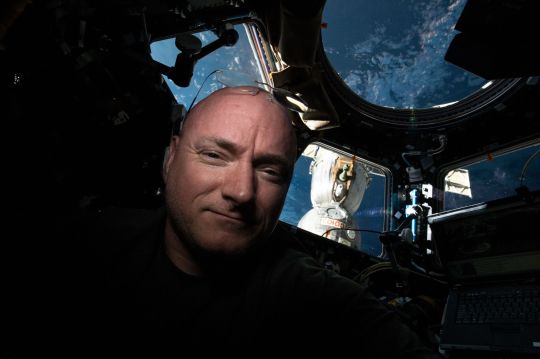What exactly happens to the human body during spaceflight? The Twins Study, a 340-day investigation conducted by NASA’s Human Research Program , sought to find answers. Scientists had an opportunity to see how conditions on the International Space Station translated to changes in gene expression by comparing identical twin astronauts: Scott Kelly who spent close to a year in space and Mark Kelly who remained on Earth.
The Process

From high above the skies, for almost a year, astronaut Scott Kelly periodically collected his own blood specimens for researchers on the ground during his One-Year Mission aboard the Space Station. These biological specimens made their way down to Earth onboard two separate SpaceX Dragon vehicles. A little bit of Scott returned to Earth each time and was studied by scientists across the United States.
Totaling 183 samples from Scott and his brother, Mark, these vials helped scientists understand the changes Scott’s body underwent while spending a prolonged stay in low Earth orbit.
The Twins

Because identical twins share the same genetic makeup, they are very similar on a molecular level. Twin studies provide a way for scientists to explore how our health is impacted by the environment around us.
What We Learned: Gene Expression

A significant
finding is the variability in gene expression, which reflects how a body
reacts to its environment and will help inform how gene expression is related
to health risks associated with spaceflight. While in space, researchers
observed changes in the expression of Scott’s genes, with the majority
returning to normal after six months on Earth. However, a small percentage of
genes related to the immune system and
DNA repair did not return to
baseline after his return to Earth. Further, the results identified
key genes to target for use in monitoring the health of future astronauts and potentially
developing personalized countermeasures.
What We Learned: Immunome

Another key finding is that Scott’s
immune system responded appropriately in space. For example, the flu vaccine administered in space
worked exactly as it does on Earth. A fully functioning immune system during
long-duration space missions is critical to protecting astronaut health from opportunistic
microbes in the spacecraft environment.
What We Learned: Proteomics

Studying protein pathways in Scott enabled researchers to look at fluid regulation and fluid shifts within his body. Shifts in fluid may contribute to vision problems in astronauts. Scientists found a specific protein associated with fluid regulation was elevated in Scott, compared with his brother Mark on Earth.
What We Learned: Telomeres
The
telomeres in Scott’s white blood cells, which are biomarkers of
aging at the end of
chromosomes, were unexpectedly longer in space
then shorter after his return to Earth with average telomere length
returning to normal six months later. In contrast, his brother’s telomeres
remained stable throughout the entire period. Because telomeres are important
for cellular genomic stability, additional studies on telomere dynamics are
planned for future one-year
missions to see whether results are repeatable for
long-duration missions.
What We Learned: Cognition

Scott Kelly participated in a series of cognitive performance evaluations (such as mental alertness, spatial orientation, and recognition of emotions) administered through a battery of tests and surveys. Researchers found that during spaceflight, Scott’s cognitive function remained normal for the first half of his stay onboard the space station compared to the second half of his spaceflight and to his brother, Mark, on the ground. However, upon landing, Scott’s speed and accuracy decreased. Re-exposure to Earth’s gravity and the dynamic experience of landing may have affected the results.
What We Learned: Biochemical

In studying various measurements on Scott, researchers found that his body mass decreased during flight, likely due to controlled nutrition and extensive exercise. While on his mission, Scott consumed about 30% less calories than researchers anticipated. An increase in his folate serum (vitamin B-9), likely due to an increase of the vitamin in his pre-packaged meals, was also noted by researchers. This is bolstered by the telomeres study, which suggests that proper nutrition and exercise help astronauts maintain health while in space.
What We Learned: Metabolomics
Within five months of being aboard the space station, researchers found an increase in the thickness of Scott’s arterial wall, which may have been caused by inflammation and oxidative stress during spaceflight. Whether this change is reversible is yet to be determined. They hope these results will help them understand the stresses that the human cardiovascular system undergoes during spaceflight.
In
addition, the results from the Microbiome, Epigenomics, and Integrative Omics
studies suggest a human body is capable of adapting to and recovering from the
spaceflight environment on a molecular level.
Why Does This Matter?

The data from the Twins Study Investigation will be explored for years to come as researchers report some interesting, surprising, and assuring data on how the human body is able to adapt to the extreme environment of spaceflight. This study gave us the first integrated molecular view into genetic changes, and demonstrated the plasticity and robustness of a human body!
We will use the valuable data to ensure the safety and health of the men and women
who go on to missions to the Moon and on to Mars.
Learn more with this video about these fascinating discoveries!
Make sure to follow us on Tumblr for your regular dose of space: http://nasa.tumblr.com


Комментариев нет:
Отправить комментарий